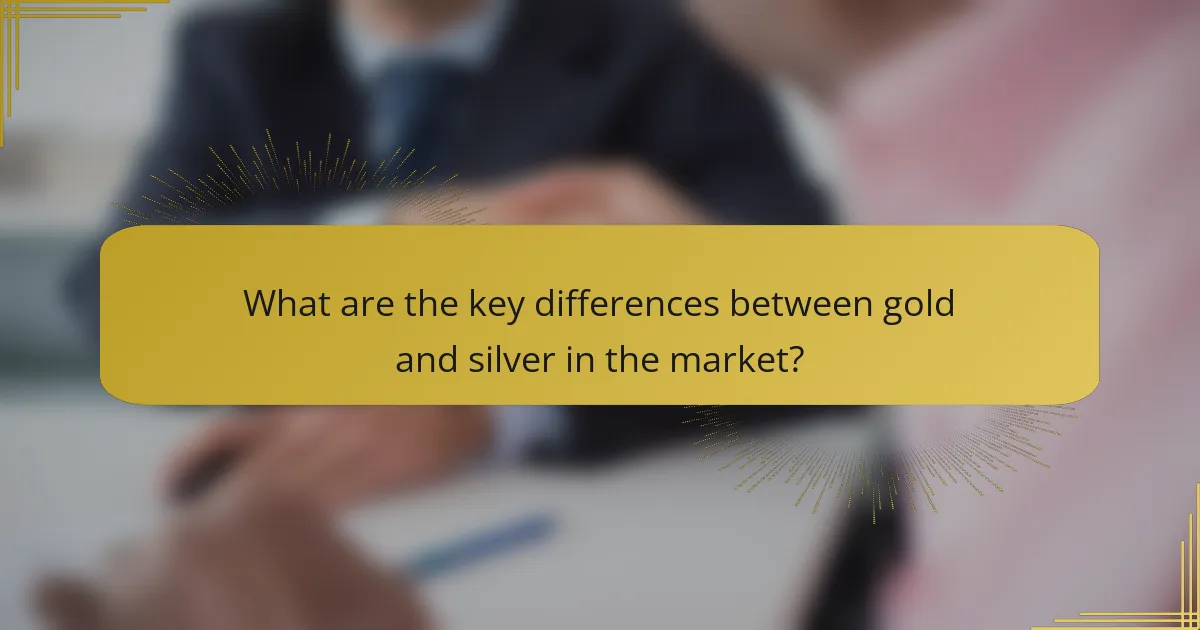Gold and silver are two prominent precious metals with distinct market behaviors and investment characteristics. Gold is valued for its scarcity, historical significance, and lower price volatility, often serving as a safe-haven asset during economic uncertainty. In contrast, silver, while also a valuable metal, experiences greater price fluctuations due to its industrial demand. The gold-to-silver ratio, which indicates the relative value of gold compared to silver, is an important metric for investors, with recent trends showing this ratio at approximately 80:1. Understanding market volatility, historical price trends, and external factors such as geopolitical events and inflation rates is crucial for making informed investment decisions regarding these precious metals.

What are the key differences between gold and silver in the market?
Gold is generally more valuable than silver in the market. This is due to gold’s scarcity and historical significance as a store of value. Gold prices are less volatile compared to silver prices. For example, in 2020, gold reached an all-time high of around $2,070 per ounce, while silver peaked at approximately $30 per ounce.
Gold is often considered a safe-haven asset during economic uncertainty. In contrast, silver is used in various industrial applications, which can affect its price based on demand fluctuations. Gold typically has a higher market liquidity than silver. This means that gold can be bought and sold more easily, reflecting its status as a primary investment vehicle.
Additionally, gold has a lower supply compared to silver, contributing to its higher price point. The gold-silver ratio, which indicates how many ounces of silver equal one ounce of gold, often fluctuates, highlighting differences in market dynamics. For instance, this ratio was around 85 in early 2021, indicating that it took 85 ounces of silver to equal one ounce of gold.
How do gold and silver prices fluctuate over time?
Gold and silver prices fluctuate due to various market factors. These factors include supply and demand dynamics, geopolitical events, and economic indicators. For instance, when demand for gold increases during economic uncertainty, prices tend to rise. Conversely, if silver supply exceeds demand, prices may decline. Historical data shows that gold prices reached a peak of approximately $2,067 per ounce in August 2020. In contrast, silver peaked around $49 per ounce in April 2011. Additionally, inflation rates and currency strength impact both metals. As the U.S. dollar weakens, gold and silver often become more attractive to investors, leading to price increases. Overall, these fluctuations are influenced by a complex interplay of global economic conditions and investor sentiment.
What historical trends can we observe in gold prices?
Gold prices have historically exhibited significant fluctuations influenced by various economic factors. From 1971 to 1980, gold prices surged from $35 to over $800 per ounce due to inflation and geopolitical tensions. In the late 1990s, prices dipped below $300 per ounce amid a strong U.S. dollar and low inflation. The 2008 financial crisis triggered a dramatic increase, with gold reaching approximately $1,900 per ounce in 2011 as investors sought safe-haven assets. Since then, prices have experienced volatility, influenced by interest rates, inflation, and global economic conditions. In 2020, gold prices surged again, surpassing $2,000 per ounce amid the COVID-19 pandemic and economic uncertainty. Overall, gold prices have shown a long-term upward trend, particularly during economic downturns and periods of high inflation.
What historical trends can we observe in silver prices?
Silver prices have historically exhibited significant volatility. Over the past century, prices have fluctuated widely due to various economic factors. For instance, in the late 1970s, silver prices surged to nearly $50 per ounce during a commodities boom. This spike was followed by a dramatic decline in the 1980s, where prices fell to around $4 per ounce.
In the early 2000s, silver began a long-term upward trend, reaching approximately $20 per ounce by 2008. The global financial crisis in 2008 further influenced silver prices, which increased to around $30 per ounce by 2011. Since then, silver has experienced fluctuations, with prices often reflecting changes in investor sentiment and economic conditions.
Overall, the historical trend of silver prices shows periods of rapid increases and sharp declines, often correlated with economic events and market changes.
What factors influence the price trends of gold and silver?
The price trends of gold and silver are influenced by various factors. Supply and demand dynamics play a crucial role in determining prices. Economic indicators, such as inflation rates and interest rates, also significantly impact precious metal values. Geopolitical tensions can lead to increased investment in gold and silver as safe-haven assets. Additionally, currency fluctuations, particularly the strength of the US dollar, affect the pricing of these metals. Historical data shows that during economic downturns, gold prices tend to rise as investors seek stability. Market speculation and investor sentiment further contribute to price volatility in gold and silver.
How do economic indicators impact gold prices?
Economic indicators significantly impact gold prices by influencing investor sentiment and market demand. When economic growth slows, gold often becomes a safe-haven asset. This was evident during the 2008 financial crisis when gold prices surged as investors sought stability. Conversely, strong economic indicators, like rising employment rates or GDP growth, can lead to lower gold prices. This occurs because investors may prefer riskier assets during economic expansion. Interest rates also play a crucial role; lower rates decrease the opportunity cost of holding gold, boosting its appeal. For instance, when the Federal Reserve lowers interest rates, gold prices typically rise. Inflation rates are another factor; high inflation diminishes currency value, prompting investment in gold as a hedge. Historical data shows that gold prices often increase during periods of high inflation, as seen in the 1970s. Thus, economic indicators directly shape gold market dynamics and pricing trends.
How do economic indicators impact silver prices?
Economic indicators significantly impact silver prices. Key indicators include inflation rates, interest rates, and economic growth data. When inflation rises, investors often seek silver as a hedge. This increased demand can drive prices up. Conversely, higher interest rates typically strengthen the dollar. A stronger dollar can lead to lower silver prices as it reduces the attractiveness of precious metals. Economic growth data influences investor sentiment. Positive growth often results in reduced demand for silver as a safe haven. Historical data shows that during economic downturns, silver prices tend to increase. For example, during the 2008 financial crisis, silver prices surged as investors sought safety. Thus, economic indicators play a crucial role in shaping silver market dynamics.

What role does market volatility play in gold and silver trading?
Market volatility significantly influences gold and silver trading. High volatility often leads to increased trading activity as investors seek safe-haven assets. Gold and silver prices typically rise during economic uncertainty, reflecting their status as protective investments. For example, during the 2008 financial crisis, gold prices surged by over 25% as market volatility increased. Similarly, silver also experienced price spikes during turbulent market conditions. Volatile markets can create both opportunities and risks for traders, impacting their strategies. Consequently, understanding market volatility is crucial for effective trading in gold and silver.
How is market volatility measured for gold and silver?
Market volatility for gold and silver is measured using several key metrics. These metrics include standard deviation, beta, and the Average True Range (ATR). Standard deviation quantifies the dispersion of price changes over a specific period. A higher standard deviation indicates greater volatility. Beta measures the asset’s price movement relative to a benchmark, typically the stock market. A beta greater than one signifies higher volatility compared to the market. The Average True Range (ATR) assesses market volatility by calculating the average range between high and low prices over a set timeframe.
These methods provide a comprehensive view of price fluctuations. Historical data, such as daily closing prices, is often used to calculate these metrics. For example, a significant increase in the standard deviation of gold prices over a month can indicate heightened market volatility. This data-driven approach helps investors make informed decisions regarding their investments in gold and silver.
What metrics are used to assess volatility in gold markets?
Volatility in gold markets is assessed using several key metrics. The most common metric is the standard deviation of gold prices. This measures the dispersion of price movements over a specific period. Another important metric is the average true range (ATR). ATR calculates market volatility by measuring the range between high and low prices over time.
The VIX index, often referred to as the “fear index,” can also be relevant. It reflects market expectations of future volatility based on options prices. Additionally, the gold volatility index (GVZ) specifically tracks gold price volatility. Each of these metrics provides insights into market fluctuations and investor sentiment.
Historical data shows that higher volatility often correlates with geopolitical tensions or economic instability. For example, during financial crises, gold prices typically exhibit increased volatility. This relationship underscores the importance of these metrics in understanding market dynamics.
What metrics are used to assess volatility in silver markets?
Common metrics used to assess volatility in silver markets include standard deviation, beta, and the Average True Range (ATR). Standard deviation measures the dispersion of silver prices from their average over a specific period. A higher standard deviation indicates greater price volatility. Beta compares silver’s price movements to a benchmark, typically the broader market. A beta greater than one suggests that silver is more volatile than the market. The Average True Range (ATR) quantifies market volatility by measuring the average range between high and low prices over a set timeframe. These metrics provide insights into the risk and price fluctuations associated with silver investments.
What are the implications of market volatility for investors?
Market volatility can significantly impact investors’ decision-making and portfolio performance. It often leads to increased uncertainty regarding asset prices. This uncertainty can cause investors to reassess their risk tolerance. During volatile periods, investors may choose to liquidate assets to avoid losses. Alternatively, some may see volatility as an opportunity to buy undervalued assets. Historical data shows that during the 2008 financial crisis, market volatility surged, leading to drastic portfolio adjustments. Additionally, research indicates that commodities like gold often serve as safe havens during market turbulence. Investors should remain aware of these dynamics to navigate volatility effectively.
How can investors mitigate risks associated with gold market volatility?
Investors can mitigate risks associated with gold market volatility by diversifying their portfolios. Diversification reduces reliance on a single asset and spreads risk across various investments. This strategy can include allocating funds to other precious metals, stocks, bonds, or real estate. Historical data shows that during economic downturns, gold often performs differently than equities. For instance, in the 2008 financial crisis, gold prices rose while stock markets fell. Additionally, using financial instruments such as options and futures can provide protection against price fluctuations. These tools allow investors to hedge against potential losses in the gold market.
How can investors mitigate risks associated with silver market volatility?
Investors can mitigate risks associated with silver market volatility by diversifying their portfolios. Diversification involves spreading investments across various assets to reduce exposure to any single asset’s price fluctuations. For instance, investors can allocate a portion of their portfolio to gold, stocks, or bonds alongside silver. Historical data shows that during periods of high silver price volatility, gold often acts as a stabilizing asset. Additionally, employing hedging strategies, such as options or futures contracts, can provide protection against adverse price movements. Research indicates that these strategies can effectively reduce potential losses in volatile markets. Regularly monitoring market trends and adjusting investment strategies accordingly also helps manage risk.

How can investors make informed decisions between gold and silver?
Investors can make informed decisions between gold and silver by analyzing their historical price trends and market volatility. Gold generally serves as a safe-haven asset during economic uncertainty. Silver, while also a precious metal, is more volatile and influenced by industrial demand.
Investors should consider the gold-to-silver ratio, which indicates how many ounces of silver are equivalent to one ounce of gold. As of October 2023, this ratio is approximately 80:1. This means that historically, silver can be undervalued compared to gold when the ratio is high.
Market trends show that during economic downturns, gold prices often rise while silver may lag behind. Conversely, in a recovering economy, silver can outperform gold due to its industrial applications.
Investors should also track geopolitical events and inflation rates. These factors can significantly impact both metals’ prices. Historical data suggests that gold has consistently maintained its value over time, whereas silver prices can fluctuate more dramatically.
In summary, informed decisions require a thorough analysis of price trends, market conditions, and the gold-to-silver ratio.
What strategies should investors consider when investing in gold?
Investors should consider diversification, dollar-cost averaging, and understanding market trends when investing in gold. Diversification involves spreading investments across various assets to reduce risk. This strategy helps mitigate losses during market downturns. Dollar-cost averaging means investing a fixed amount in gold at regular intervals. This approach reduces the impact of price volatility over time. Understanding market trends involves analyzing factors like inflation, interest rates, and geopolitical events. Historical data shows that gold often retains value during economic uncertainty. For example, during the 2008 financial crisis, gold prices surged as investors sought safe-haven assets.
What are the benefits of long-term investment in gold?
Long-term investment in gold offers several benefits. It serves as a hedge against inflation, preserving purchasing power over time. Historical data shows that gold prices tend to rise during economic downturns. This makes gold a safe haven asset during market volatility. Additionally, gold has low correlation with stocks and bonds, providing diversification in an investment portfolio. According to the World Gold Council, gold has outperformed many asset classes over the long term. Investors often turn to gold during geopolitical uncertainties, reinforcing its role as a reliable store of value. The liquidity of gold also allows for easy buying and selling in various markets.
What are the risks associated with short-term gold trading?
Short-term gold trading carries several risks. Price volatility is a significant concern. Gold prices can fluctuate dramatically in short time frames. This volatility can lead to substantial financial losses. Additionally, transaction costs can erode profits. Frequent buying and selling incur fees that accumulate quickly. Market timing poses another risk. Predicting price movements accurately is challenging. Traders may make decisions based on emotions rather than analysis. Lastly, leverage can amplify losses. Using borrowed funds increases potential risks in short-term trades.
What strategies should investors consider when investing in silver?
Investors should consider diversification, market timing, and understanding silver’s industrial demand when investing in silver. Diversification helps mitigate risks associated with market fluctuations. Investors should allocate a portion of their portfolio to silver alongside other assets. Market timing involves analyzing price trends and economic indicators. Historical data shows that silver prices can be volatile, influenced by global economic conditions. Understanding silver’s industrial demand is crucial. Approximately 50% of silver is used in industrial applications, such as electronics and solar panels. This demand can significantly impact silver prices. Investors should also consider physical silver versus silver ETFs. Physical silver provides tangible ownership, while ETFs offer liquidity and ease of trading.
What are the benefits of long-term investment in silver?
Long-term investment in silver offers several benefits. Silver has historically acted as a hedge against inflation. During economic downturns, silver often retains value better than other assets. The demand for silver in industrial applications also supports its price. Additionally, silver has a lower entry cost compared to gold, making it accessible for more investors. Over the last 50 years, silver has shown significant price appreciation, outperforming inflation rates. According to the Silver Institute, global silver demand reached 1.05 billion ounces in 2022, indicating strong market interest. This demand, combined with limited supply, can drive prices higher over time.
What are the risks associated with short-term silver trading?
Short-term silver trading carries several risks. Price volatility is a significant concern, as silver prices can fluctuate dramatically within short periods. This volatility can lead to substantial losses if trades are poorly timed. Market liquidity is another risk; during times of low trading volume, it may be challenging to execute trades at desired prices. Additionally, leverage can amplify losses, increasing the potential for financial strain. Traders may also face unexpected market events that can impact silver prices rapidly. Lastly, transaction costs can erode profits, especially for frequent traders.
What practical tips can help investors navigate the gold and silver markets?
Investors can navigate the gold and silver markets by staying informed about market trends. Regularly monitoring price movements helps identify buying and selling opportunities. Understanding the factors that influence prices, such as inflation and geopolitical events, is crucial. Diversifying investments across both metals can reduce risk. Utilizing reputable sources for market analysis enhances decision-making. Setting clear investment goals aids in maintaining focus during market fluctuations. Keeping track of historical price data provides context for current trends. Engaging with expert opinions can offer valuable insights into market dynamics.
The main entity of this article is the comparison between gold and silver, focusing on their price trends and market volatility. The article outlines the key differences in market value, liquidity, and volatility between these two precious metals, highlighting factors that influence their prices, such as supply and demand dynamics, economic indicators, and geopolitical events. Historical trends in gold and silver prices are examined, along with strategies for investors to navigate the markets and mitigate risks associated with volatility. Additionally, the article discusses the implications of market fluctuations for investment decisions in gold and silver.